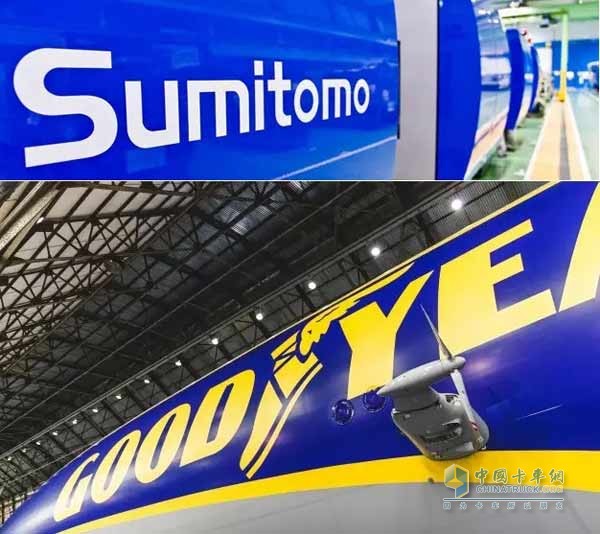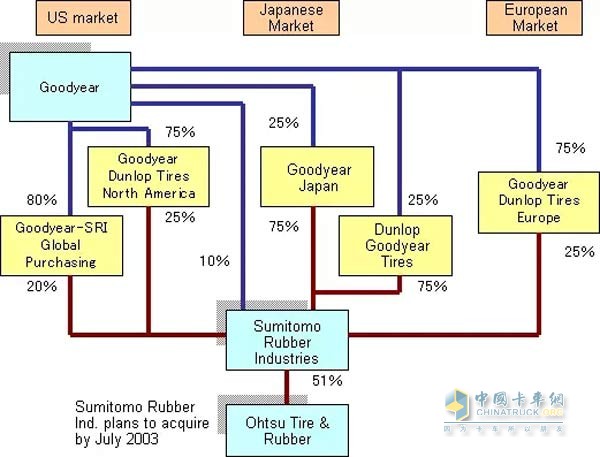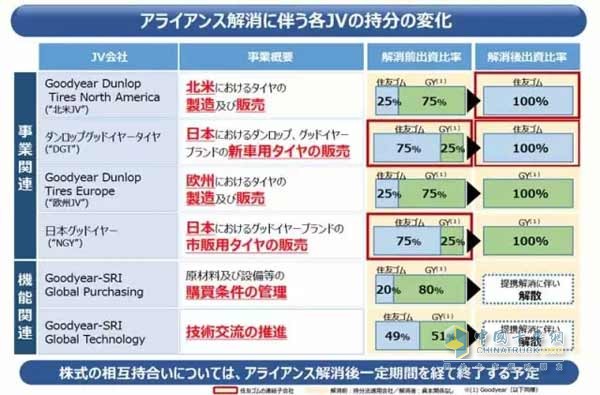Goodyear Tire & Rubber Company today announced that it has reached an agreement with Sumitomo Rubber Industries, Ltd. (Sumitomo Rubber Industries, Ltd., SRI ) ( hereinafter referred to as "Sumitomo Rubber"), the dissolution of a global alliance between the two companies.

Goodyear and Sumitomo Oak have reached an agreement to dissolve the global alliance
Goodyear and Sumitomo Rubber established a global alliance in 1999. The alliance consists of four joint venture companies, one in North America and Europe, and two in Japan.
Mr. Richard J. Kramer, chairman and chief executive officer, said: "Although this alliance has brought value to us in the past 16 years, now Goodyear has enough ability to practice it. Its own strategy: The smooth dissolution of the alliance will increase our flexibility for profitable growth, because our focus has always been on creating strong performance and sustainable economic value."
Mr. Kramer added: "We are committed to achieving a smooth and orderly transition that will provide seamless connectivity to customers and consumers in North America, Europe and Japan."
The final settlement of the agreement will resolve the pending arbitration that was submitted in January 2014. This agreement can save the two companies from the cost and uncertainty of the arbitral proceedings.

Goodyear and Sumitomo Rubber Agreement Framework 
Goodyear and Sumitomo Oak have reached an agreement to dissolve the global alliance
Agreement Overview
North American joint venture
Sumitomo Rubber (currently holding a 25% stake) will acquire Goodyear's 75% stake in Goodyear Dunlop North America/North America joint ventures, including full ownership of the joint venture New York Tona Wanda Plant; The company manufactures and sells Dunlop brand tires primarily in North America.
In the North American and Mexican markets, Goodyear will have exclusive rights to non-Japanese car manufacturers to supply or replace Dunlop brand tires; Sumitomo Rubber will be able to sell Dunlop brand tires to all Japanese car manufacturers.
European joint venture
Goodyear, which currently holds a 75% stake, will acquire Sumitomo Rubber's 25% stake in Goodyear Dunlop Tyre Europe (GDTE).
In much of Europe, Goodyear holds exclusive sales rights for Dunlop brand tires.
In previous global alliances, certain countries where Goodyear does not have exclusive sales rights, including Russia, Turkey, and certain African countries, Sumitomo Rubber will acquire exclusive sales rights for Dunlop brand tires.
Japanese joint venture
Goodyear, which currently holds a 25% stake, will acquire Sumitomo Rubber's 75% stake in Goodyear, which will have the exclusive right to provide Goodyear replacement tires and matching tires for the Japanese market.
Sumitomo Rubber (currently holding a 75% stake) will acquire Goodyear's 25% stake in Dunlop Goodyear Tire, and will provide exclusive rights to Dunlop to replace its tires and matching tires for the Japanese market.
Financial terms of the agreement
According to the terms of the agreement, Goodyear will pay Sumitomo Rubber 271 million U.S. dollars (approximately 1.68 billion yuan) at the end of this transaction and expects to complete payment in the fourth quarter of 2015. This transaction will not affect the company's existing financial goals or capital allocation plans for 2015 and 2016. Expenses will be included in the approximately 600 million U.S. dollars allocated for restructuring by the capital allocation plan. In addition, Goodyear will repay approximately $55 million in debt to Sumitomo Rubber within the next three years. As a result of this agreement, Goodyear will also sell 3.4 million Sumitomo Rubber common stocks.
Goodyear expects that the deal will affect its earnings from the first quarter of 2016 and is mainly related to the sale of a minority stake in Goodyear Dunlop Tyre Europe. According to the company's business plan for 2015, the net dividend-adjusted annual dividend is approximately $40 million to $50 million (15-18 cents per share).
This transaction has yet to meet some of the usual settlement conditions, including the approval of regulatory authorities, and the conclusion of a labor agreement between Sumitomo Rubber and the Tonawada Plant Joint Steel Workers Union.
ALFA LAVAL Plate Heat Exchanger
Alfa Laval Heat Exchanger
Double-Wall Plate Heat ExchangerGasketed plate heat exchangers (PHE) meets almost all of heat transfer requirements. They are highly flexible with a wide range of models. Connection sizes range from 1″ to 16″. Plate materials are available in a wide variety such as stainless steel 316, 304 and titanium. Other alloys for corrosive applications such as Hastelloy, Nickel and monel are also available.
A flat Plate Heat Exchanger transfers heat between two different fluids using metal plates to separate the fluids. The fluids move between the gaps in the plates. The plates are corrugated in a chevron pattern causing high turbulence in the fluids. The high turbulence and high surface area of the plates results in a higher efficiency of heat transfer than conventional shell and tube heat exchangers.
Advantages of Plate Heat Exchangers:
Because the flow pattern causes high turbulence of the fluids through alternate channels – this results in a higher heat transfer rate allowing for a more compact design reducing material cost since the heat transfer surface requirement is much lower than a conventional heat exchanger.
High turbulence results in less fouling – therefore less down time for maintenance.
Easily add capacity as expansion is required by adding plates to the heat exchanger.
Can be opened without disturbing the piping.
Closer temperature approaches of up to 2°F maximizes heat recovery for a wide variety of applications.
Minimal space required for opening or closing the heat exchanger allows for easy maintenance.
Ideal for mounting on a skid.
Flow principle of Plate And Frame Heat Exchangers:
Plate and frame heat exchangers consists of a pack of thin metal plates with openings for the passage of the fluids. The plates are corrugated which means that each pair of adjacent plates in the heat exchanger forms a channel. Every second channel is open to the same fluid. Between each pair of plates there is a rubber gasket, which prevents the fluids from mixing and from leaking to the surroundings.
When the media enters the plate and frame heat exchanger via the connections in the frame, it`s directed through alternate channels by the gasket arrangement. The warm fluid flows through every other channel and the cold fluid through the channels in between. Heat is thus transferred from the warm fluid to the colder fluid via the dividing wall, i.e. the plate material. The corrugations support the plates against differential pressure and create a turbulent flow in the channels. In turn, the turbulent flow provides high heat transfer efficiency, making the plate heat exchanger very compact compared with the traditional shell-and-tube heat exchanger.
The Double-Wall Plate Heat Exchanger:
For fluids that must be kept separate
The Double-Wall Plate Heat Exchanger is a technical breakthrough for heat exchange for media between which a hostile or undesirable reaction can occur, if the two fluids should mix. The Double-Wall Plate Heat Exchanger is therefore a new alternative to traditional heat transfer equipment such as the double-wall shell-and-tube heat exchanger, the triple-tube shell-and-tube heat exchanger, the double-circuit intercooler, and coils for indirect heating.
Alfa Laval Plate,0.5Mm Plate For Heat Exchanger,Heat Exchanger 0.5Mm Hastelloy Plate,High-Theta Plate For Heat Exchanger
Liaoning LotusNine International Trade co.,ltd , https://www.lj-heatexchangers.com
![<?echo $_SERVER['SERVER_NAME'];?>](/template/twentyseventeen/skin/images/header.jpg)